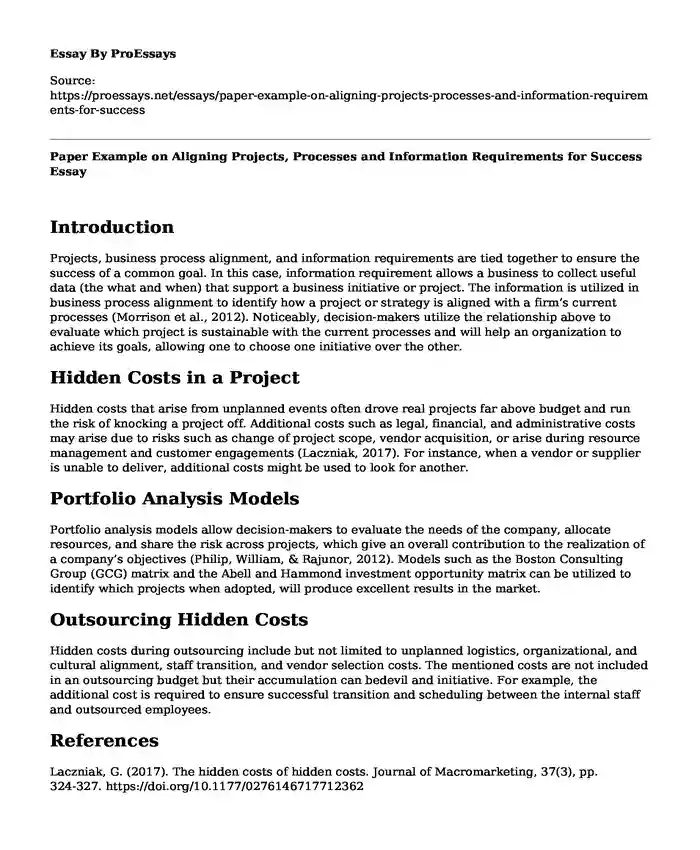Introduction
Projects, business process alignment, and information requirements are tied together to ensure the success of a common goal. In this case, information requirement allows a business to collect useful data (the what and when) that support a business initiative or project. The information is utilized in business process alignment to identify how a project or strategy is aligned with a firm’s current processes (Morrison et al., 2012). Noticeably, decision-makers utilize the relationship above to evaluate which project is sustainable with the current processes and will help an organization to achieve its goals, allowing one to choose one initiative over the other.
Hidden Costs in a Project
Hidden costs that arise from unplanned events often drove real projects far above budget and run the risk of knocking a project off. Additional costs such as legal, financial, and administrative costs may arise due to risks such as change of project scope, vendor acquisition, or arise during resource management and customer engagements (Laczniak, 2017). For instance, when a vendor or supplier is unable to deliver, additional costs might be used to look for another.
Portfolio Analysis Models
Portfolio analysis models allow decision-makers to evaluate the needs of the company, allocate resources, and share the risk across projects, which give an overall contribution to the realization of a company’s objectives (Philip, William, & Rajunor, 2012). Models such as the Boston Consulting Group (GCG) matrix and the Abell and Hammond investment opportunity matrix can be utilized to identify which projects when adopted, will produce excellent results in the market.
Outsourcing Hidden Costs
Hidden costs during outsourcing include but not limited to unplanned logistics, organizational, and cultural alignment, staff transition, and vendor selection costs. The mentioned costs are not included in an outsourcing budget but their accumulation can bedevil and initiative. For example, the additional cost is required to ensure successful transition and scheduling between the internal staff and outsourced employees.
References
Laczniak, G. (2017). The hidden costs of hidden costs. Journal of Macromarketing, 37(3), pp. 324-327. https://doi.org/10.1177/0276146717712362
Morrison E.D., Ghose A.K., Dam H.K., Hinge K.G., Hoesch-Klohe K. (2012). Strategic alignment of business processes. In: Pallis G. et al. (eds) Service-Oriented Computing - ICSOC 2011 Workshops. ICSOC 2011. Lecture Notes in Computer Science, vol 7221. Springer, Berlin, Heidelberg. https://doi.org/10.1007/978-3-642-31875-7_3
Philip, T. U., William, E. E., & Rajunor, B. A. (2012). Portfolio analysis models: A review. European Journal of Business and Management, 4(18), pp. 101-120. Retrieved from https://www.google.com/url?sa=t&rct=j&q=&esrc=s&source=web&cd=&ved=2ahUKEwjExPSOo6TqAhU_DmMBHRa_AVEQFjABegQIARAB&url=http%3A%2F%2Fwww.iiste.org%2FJournals%2Findex.php%2FEJBM%2Farticle%2Fdownload%2F3228%2F3278&usg=AOvVaw1ywJVHh5b_44Y7jdLsVbVa
Cite this page
Paper Example on Aligning Projects, Processes and Information Requirements for Success. (2023, Sep 19). Retrieved from https://proessays.net/essays/paper-example-on-aligning-projects-processes-and-information-requirements-for-success
If you are the original author of this essay and no longer wish to have it published on the ProEssays website, please click below to request its removal:
- The Relationship Between Empowering Leadership and Intention to Share Knowledge in the Context of NGOs
- Case Study Around the Fundamentals of Project Management
- Materials for CEO of Ursula M. Burns and Ms. Gibbons Paper Example
- Essay on Target: Cheap But Fashionable Retail Giant Growing Globally
- Essay Example on FORD's Transformation: Crafting a New Vision.
- Paper Sample on Agricultural Sustainability - A Balanced Perspective
- The Sendai Framework for Disaster Risk Reduction - Report Sample







